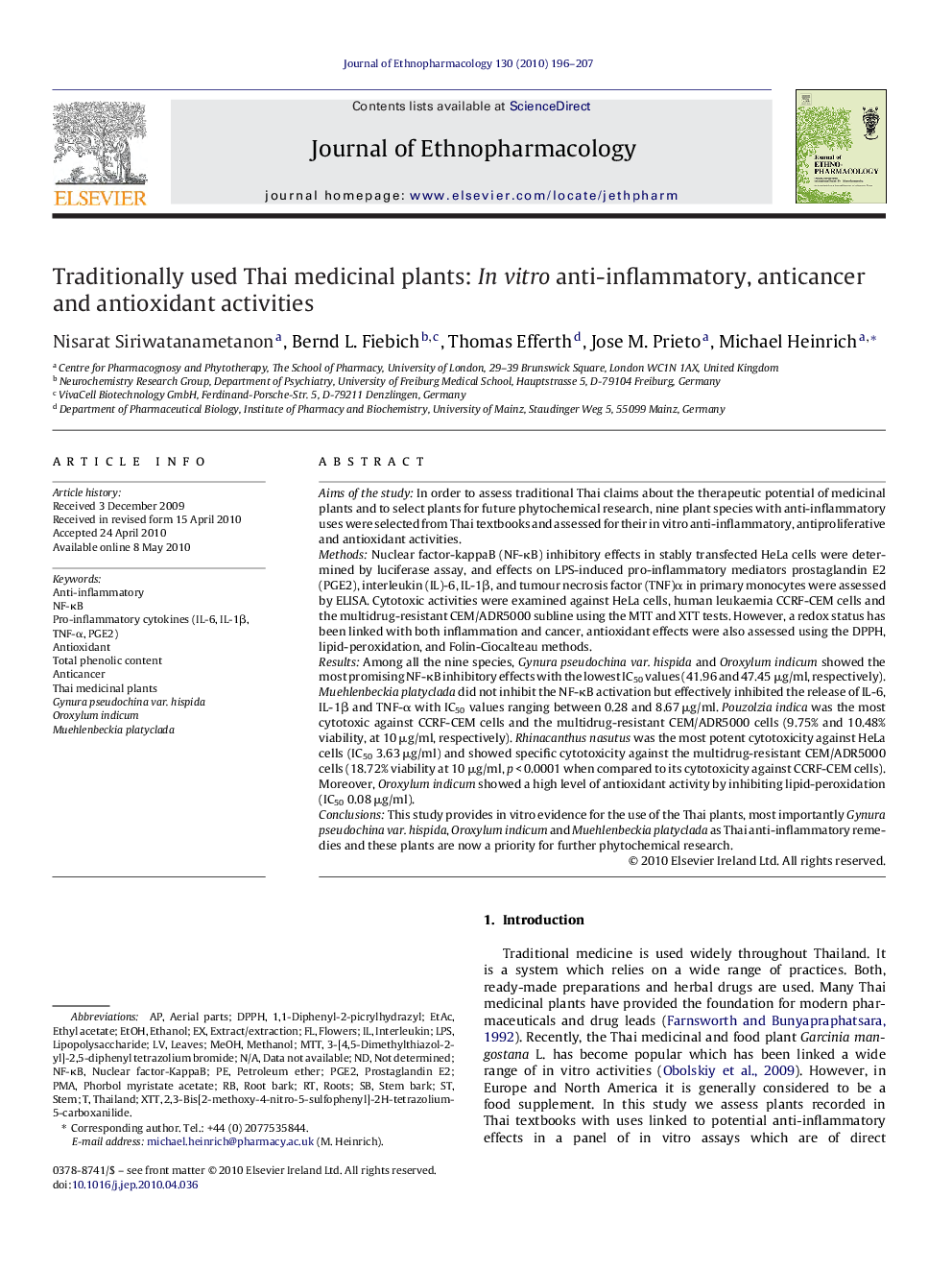| کد مقاله | کد نشریه | سال انتشار | مقاله انگلیسی | نسخه تمام متن |
|---|---|---|---|---|
| 2545937 | 1124011 | 2010 | 12 صفحه PDF | دانلود رایگان |

Aims of the studyIn order to assess traditional Thai claims about the therapeutic potential of medicinal plants and to select plants for future phytochemical research, nine plant species with anti-inflammatory uses were selected from Thai textbooks and assessed for their in vitro anti-inflammatory, antiproliferative and antioxidant activities.MethodsNuclear factor-kappaB (NF-κB) inhibitory effects in stably transfected HeLa cells were determined by luciferase assay, and effects on LPS-induced pro-inflammatory mediators prostaglandin E2 (PGE2), interleukin (IL)-6, IL-1β, and tumour necrosis factor (TNF)α in primary monocytes were assessed by ELISA. Cytotoxic activities were examined against HeLa cells, human leukaemia CCRF-CEM cells and the multidrug-resistant CEM/ADR5000 subline using the MTT and XTT tests. However, a redox status has been linked with both inflammation and cancer, antioxidant effects were also assessed using the DPPH, lipid-peroxidation, and Folin-Ciocalteau methods.ResultsAmong all the nine species, Gynura pseudochina var. hispida and Oroxylum indicum showed the most promising NF-κB inhibitory effects with the lowest IC50 values (41.96 and 47.45 μg/ml, respectively). Muehlenbeckia platyclada did not inhibit the NF-κB activation but effectively inhibited the release of IL-6, IL-1β and TNF-α with IC50 values ranging between 0.28 and 8.67 μg/ml. Pouzolzia indica was the most cytotoxic against CCRF-CEM cells and the multidrug-resistant CEM/ADR5000 cells (9.75% and 10.48% viability, at 10 μg/ml, respectively). Rhinacanthus nasutus was the most potent cytotoxicity against HeLa cells (IC50 3.63 μg/ml) and showed specific cytotoxicity against the multidrug-resistant CEM/ADR5000 cells (18.72% viability at 10 μg/ml, p < 0.0001 when compared to its cytotoxicity against CCRF-CEM cells). Moreover, Oroxylum indicum showed a high level of antioxidant activity by inhibiting lipid-peroxidation (IC50 0.08 μg/ml).ConclusionsThis study provides in vitro evidence for the use of the Thai plants, most importantly Gynura pseudochina var. hispida, Oroxylum indicum and Muehlenbeckia platyclada as Thai anti-inflammatory remedies and these plants are now a priority for further phytochemical research.
In vitro anti-inflammatory, cytotoxicity, and antioxidant activities of nine anti-inflammatory remedies used traditionally in Thailand – Basella alba, Basella rubra (Basellaceae), Cayratia trifolia (Vitaceae), Gynura pseudochina var. hispida, Gynura pseudochina (Asteraceae), Muehlenbeckia platyclada (Polygonaceae), Oroxylum indicum (Bignoniaceae), Pouzolzia indica (Urticaceae), and Rhinacanthus nasutus (Acanthaceae) – allowed the selection of lead extracts for further ethnopharmacological research, most importantly Gynura pseudochina var. hispida.Figure optionsDownload as PowerPoint slide
Journal: Journal of Ethnopharmacology - Volume 130, Issue 2, 20 July 2010, Pages 196–207